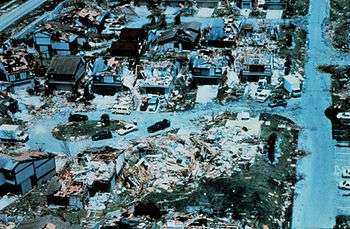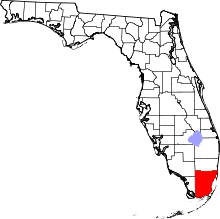Country Walk, Florida
| Country Walk, Florida | |
|---|---|
| CDP | |
 Location in Miami-Dade County and the state of Florida | |
 U.S. Census Bureau map showing CDP boundaries | |
| Coordinates: 25°37′56″N 80°26′6″W / 25.63222°N 80.43500°WCoordinates: 25°37′56″N 80°26′6″W / 25.63222°N 80.43500°W | |
| Country |
|
| State |
|
| County | Miami-Dade |
| Area | |
| • Total | 2.7 sq mi (7.1 km2) |
| • Land | 2.7 sq mi (7.1 km2) |
| • Water | 0 sq mi (0 km2) |
| Elevation | 7 ft (2 m) |
| Population (2000) | |
| • Total | 10,653 |
| • Density | 3,945.6/sq mi (1,500.4/km2) |
| Time zone | Eastern (EST) (UTC-5) |
| • Summer (DST) | EDT (UTC-4) |
| FIPS code | 12-15055[1] |
| GNIS feature ID | 1853243[2] |
Country Walk is a census-designated place (CDP) Miami suburb in Miami-Dade County, Florida, United States. The population was 15,997 at the 2010 census.
Geography

Country Walk is located at 25°37′56″N 80°26′6″W / 25.63222°N 80.43500°W (25.632332, -80.434956).[3]
According to the United States Census Bureau, the CDP has a total area of 2.8 square miles (7.3 km2), of which, 2.8 square miles (7.3 km2) of it is land and 0.36% is water.
History
In August 1992, Country Walk was severely destroyed by Hurricane Andrew. 90% of the 1,700 homes in Country Walk were destroyed. Following the hurricane, property owners filed lawsuits against the developer of Country Walk, Arvida for shoddy construction. In the subsequent years, the homes were slowly rebuilt. Unlike the destroyed homes which were made of wood frame construction, the new homes were rebuilt with concrete walls. Although many areas of Miami were heavily affected by Hurricane Andrew, Country Walk was one of the worst affected and remains a reminder of the hurricane's extensive disaster in the CDP today.[4][5]
Demographics
| Historical population | |||
|---|---|---|---|
| Census | Pop. | %± | |
| 2000 | 10,653 | — | |
| 2010 | 15,997 | 50.2% | |
| source:[6] | |||
As of the census[1] of 2000, there were 10,653 people, 3,234 households, and 2,820 families residing in the CDP. The population density was 3,879.0 people per square mile (1,495.7/km²). There were 3,409 housing units at an average density of 1,241.3/sq mi (478.6/km²). The racial makeup of the CDP was 77.60% White (28.6% were Non-Hispanic White,)[7] 10.66% African American, 0.10% Native American, 2.52% Asian, 0.05% Pacific Islander, 5.00% from other races, and 4.06% from two or more races. Hispanic or Latino of any race were 56.13% of the population.
There were 3,234 households out of which 56.9% had children under the age of 18 living with them, 71.3% were married couples living together, 12.3% had a female householder with no husband present, and 12.8% were non-families. 9.7% of all households were made up of individuals and 1.4% had someone living alone who was 65 years of age or older. The average household size was 3.29 and the average family size was 3.51.
In the CDP the population was spread out with 32.7% under the age of 18, 6.7% from 18 to 24, 38.5% from 25 to 44, 17.0% from 45 to 64, and 5.0% who were 65 years of age or older. The median age was 32 years. For every 100 females there were 91.4 males. For every 100 females age 18 and over, there were 86.0 males.
The median income for a household in the CDP was $63,689, and the median income for a family was $66,250. Males had a median income of $41,798 versus $30,987 for females. The per capita income for the CDP was $20,736. About 3.5% of families and 4.8% of the population were below the poverty line, including 3.8% of those under age 18 and 17.6% of those age 65 or over.
As of 2000, Spanish was the first language for 61.78% of all residents, while English accounted for 35.79%, Urdu accounted for 1.02%, Portuguese made up 0.59%, French was 0.48%, and French Creole was the mother tongue for 0.31% of the population.[8]
References
- 1 2 "American FactFinder". United States Census Bureau. Archived from the original on 2013-09-11. Retrieved 2008-01-31.
- ↑ "US Board on Geographic Names". United States Geological Survey. 2007-10-25. Retrieved 2008-01-31.
- ↑ "US Gazetteer files: 2010, 2000, and 1990". United States Census Bureau. 2011-02-12. Retrieved 2011-04-23.
- ↑ http://www.miamiherald.com/2012/08/17/2956273/photo-gallery-08-17-141113.html
- ↑ http://www.miamiherald.com/2012/08/18/2958131/the-fury-of-andrew.html
- ↑ "CENSUS OF POPULATION AND HOUSING (1790-2000)". U.S. Census Bureau. Retrieved 2010-07-17.
- ↑ "Demographics of Country Walk, FL". MuniNetGuide.com. Retrieved 2007-12-16.
- ↑ "MLA Data Center Results for Country Walk, Florida". Modern Language Association. Retrieved 2007-12-16.
